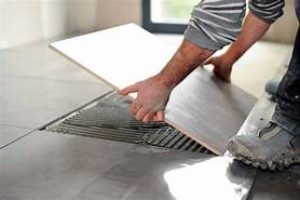Normal wear and tear and damaging chemicals can affect the finishes of your natural stone surfaces. Fortunately, natural stone is a durable material that can be brought back to life with professional stone restoration.
Certain stones, like marble, travertine, or limestone, are acid sensitive. It’s very hard in a kitchen or bar to avoid any spilling of things that can etch the stone, and these stones will usually need to be restored more often. Using neutral cleaners will keep your stone looking good longer, but harsher chemicals can quickly damage the finish of certain stones.
How Natural Stone is Restored
If your stone looks soiled or worn, we will send an estimator to your home to diagnose your project and determine whether it needs light maintenance, maintenance, restoration, or repair.
Grout joints are the biggest storyteller they can be stained or dirty from improper care, but they can also be cracked and degraded, which presents problems beyond maintenance. A good estimator will determine if the surface needs cleaning and sealing, repolishing, rehoning, or repair.
The restoration process is similar to wet sanding and involves the application of a cream or powder abrasive. If the stone has extensive damage, the restorer will use a floor or hand machine with an industrial diamond disc. The process exfoliates the surface of the stone. Then, depending on the finish, the stone will be repolished or rehoned. Restoration could take multiple days to complete
It’s an intricate process that takes between three and seven steps. The timeframe is often longer than most people expect. Restoration isn’t simply squirting a topical wax on surface. The extent of the process depends on the condition, size and how much TLC is needed.
Communication with your restorer throughout the process is key. In case of kitchen or bathroom countertop, for example, determine who will remove the fixtures of the sink. So the restorer can get as close as they can.
After Restoration
Once the process is complete, the restorer will typically seal the stone. How quickly you can use it will depend on the surface.
It can be dry to touch but the sealer might need to cure and will not be effective for a certain amount of hours. The contractor should also provide care instructions and general housekeeping tips. You will want to keep the surface clean with a good stone soap. Dusting the surface to remove grit and residue is advised.
A lot of homeowners wonder why sealing doesn’t provide protection. The sealers that restorers use are penetrating sealers, not a coating or wax. They soak into the pores of the stone and help repel grease or oil, but they don’t stop acid or other chemicals from etching or slightly burning the surface.
Restoring your stone can bring it back to the look and luster it had when it was originally installed. Part of the beauty of natural stone is that the process can be repeated without worry so you can enjoy your investment for a lifetime.
Free Inspection and Estimates
MVP offers Free inspections, estimates and a yearly service plan. Feel free to call us any time to schedule an appointment.







Leave a Reply
Your email is safe with us.